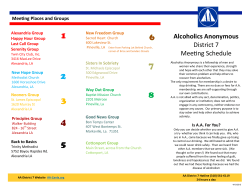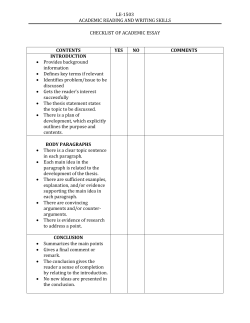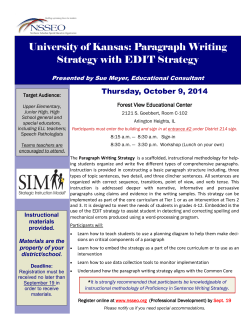
Metacognitive Skills in Literacy Series B Part I: Clarifying
Metacognitive Skills in Literacy Series B Part I: Clarifying and Curriculum Refresher 1 Alexandria City Public Schools, Dept. of C and I How can we ensure our students are metacognitive readers? 2 Alexandria City Public Schools, Dept. of C and I Curriculum Version 3.0 Upgrades Key Academic Vocabulary Transfer Tasks: 3 Versions, Parallel in Content and Process Comprehension Guided/Scaffolded Accelerated/Enhanced Measurement Topices: focused, reduced number Scoring Rubrics with student feedback suggestions. 3 Alexandria City Public Schools, Dept. of C and I Monitoring Comprehension How do you monitor comprehension? 4 How do you know How do you fix-it when you are not when you are not understanding? understanding? Alexandria City Public Schools, Dept. of C and I Inner Voice We need our students to listen to their inner voice as they read to know when it makes sense and when it does not. 5 Alexandria City Public Schools, Dept. of C and I A lot of kids don’t realize they’ve lost their way when reading. They think if they rush through the words and turn the pages, they’re ‘getting through it.’” Seven Keys to Comprehension, p. 150. 6 Alexandria City Public Schools, Dept. of C and I A reader’s job is to know when text makes sense and when it does not. 7 Alexandria City Public Schools, Dept. of C and I Inner Voice 8 Oh no! Yes! Huh? Wow, I didn’t know that! Neat! I’m lost, whose talking? What is going on here? What are they talking about? What am I going to do after school? How much more time until lunch? Alexandria City Public Schools, Dept. of C and I My Inner Voice Is Saying Page My Voice Says: 9 Alexandria City Public Schools, Dept. of C and I Your Turn Partners Task 1 and 3 Read page 17 through first paragraph on page 18 – stopping after every paragraph 2 and 4 Share what inner voice is saying at end of every paragraph. 2 and 4 Read p. 18 – stopping after every paragraph 1 and 3 Share what inner voice is saying at end of every paragraph. 10 Alexandria City Public Schools, Dept. of C and I Inner Voice Sayings 1) Inner voice examples that shows the reader is understanding the text. 2) Inner voice examples that shows the reader has questions about the text. 11 Alexandria City Public Schools, Dept. of C and I When the Inner Voice Says: Huh? Re-reading Reading ahead Asking questions Drawing inferences Sounding out words Chunking words Using context clues Stopping to think Asking a peer Asking a teacher/parent Connecting the reading to what I already know Looking at the pictures or other text features 12 Writing about the confusing part Alexandria City Public Schools, Dept. of C and I Remembering the purpose for why I am reading Your Turn Partners 1 and 3 1 and 3 2 and 4 2 and 4 2 and 4 1 and 3 Task Read paragraph at bottom of page 24 that ends on top of page 26 Tell partner 2 or 4 what the paragraph just said Share any fix-it strategies they observed partner 1 or 3 use while reading. Read second paragraph on page 26 Tell partner 1 or 3 what the paragraph just said Share any fix-it strategies they observed partner 2 or 4 use while reading. 1, 2, 3, and Repeat process until you have read through page 29 4 13 Alexandria City Public Schools, Dept. of C and I Plan Your Think-Alouds Good think-alouds take careful preplanning. As a good reader, it is difficult to slow down your thinking and verbalize it so other can ‘see’ what is happening in your brain as you read. 14 Alexandria City Public Schools, Dept. of C and I 15 Alexandria City Public Schools, Dept. of C and I Evidence of Metacognition What data and/or evidence can we collect on our students ability to use clarifying strategies? 16 Alexandria City Public Schools, Dept. of C and I Our Evidence Our data points on the effectiveness of teaching our students to clarify will be: 17 Alexandria City Public Schools, Dept. of C and I Strategy Instruction 1) Model strategy through a ThinkAloud. 2) Support guided practice with a partner or team so that students are verbalizing their inner voice. 3) Provide independent practice. 18 Alexandria City Public Schools, Dept. of C and I Planning for Instruction Read and think through the Transfer Task students will be asked to complete. What will they need to know and do in order to be successful on this task. What text do they need to read in order to acquire some of the learning need for success? Which of these texts will you use for modeling clarifying? Do you have your script/notes for your think-aloud followed by guided practice? What assessments will you use in this unit: pre-assessment, formative assessments, summative assessments? What will be your daily plans for: Framing the Lesson Presenting Information and Creating Engagement Consolidating and Anchoring the Lesson 19 Alexandria City Public Schools, Dept. of C and I
© Copyright 2025





















